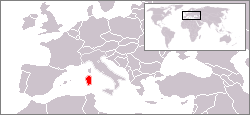Sardinian lynx
| Sardinian lynx[1] | |
|---|---|
| Scientific classification | |
| Kingdom: | Animalia |
| Phylum: | Chordata |
| Class: | Mammalia |
| Order: | Carnivora |
| Family: | Felidae |
| Genus: | Lynx |
| Species: | L. lynx |
| Subspecies: | L. l. sardiniae |
| Trinomial name | |
| Lynx lynx sardiniae (Mola, 1908) | |
 | |
| Former range (in red) | |
The Sardinian lynx is an extinct subspecies of the Eurasian lynx that once could be found on the Italian island of Sardinia.
In 1908, Pasquale Mola described a lynx from Nuoro (Sardinia) as Lynx sardiniae. The length of the Sardinian lynx was 1 m; the height 35 cm and the tail 33 cm. The cheeks were distinctly whiskered and the ears were tufted. The back was reddish with the dorsal area almost forming a band. The sides were reddish grey. The head, neck and shoulder, and flanks with reddish brown or greyish brown spots. The legs had transverse tawny stripes. The tail had a black tip and three black sub-terminal rings. This subspecies had also a head with black stripe on each side beginning at the mouth and passing back through the eye to the side of the neck. The ears were tawny inside and reddish outside, tending towards black. The underparts and inner surface of the legs are dirty white with a reddish tinge.[2] They competed for food with the Sardinian dhole, a canid living with the lynx. Evidence of the existence of the lynx on the island have never been collected in historical times. It is therefore considered that the reporting by Mola is not to be considered valid for the present time.
See also
References
| Wikispecies has information related to: Sardinian lynx |
| Wikimedia Commons has media related to Sardinian lynx. |
- ↑ Wozencraft, W.C. (2005). "Order Carnivora". In Wilson, D.E.; Reeder, D.M. Mammal Species of the World: A Taxonomic and Geographic Reference (3rd ed.). Johns Hopkins University Press. pp. 532–628. ISBN 978-0-8018-8221-0. OCLC 62265494.
- ↑ Miller, G. S. (1912). Catalogue of the Mammals of Western Europe (Europe exclusive of Russia) in the collection of the British Museum. Trustees of the British Museum (Natural History) London.